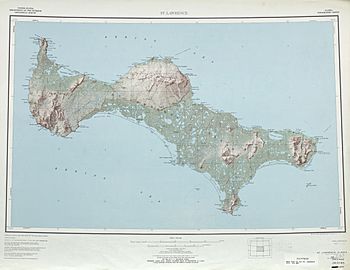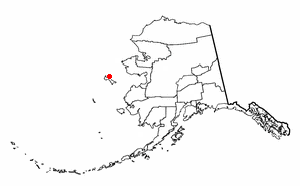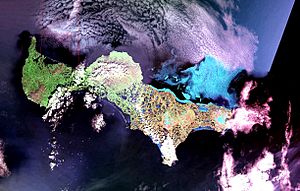St. Lawrence Island facts for kids

Closeup map of St. Lawrence Island
|
|
|
Location in Alaska
|
|
| Geography | |
|---|---|
| Location | Bering Sea |
| Coordinates | 63°21′44″N 170°16′02″W / 63.36222°N 170.26722°W |
| Area | 1,791.56 sq mi (4,640.1 km2) |
| Length | 90 mi (140 km) |
| Width | 22 mi (35 km) |
| Highest point | Atuk Mountain, 2,070 ft (630 m) |
| Administration | |
|
United States
|
|
| State | Alaska |
| Census Area | Nome Census Area |
| Largest settlement | Savoonga (pop. 835, 2020) |
| Demographics | |
| Population | 1,475 (2020) |
| Pop. density | 0.32 /km2 (0.83 /sq mi) |
| Ethnic groups | Siberian Yupik |
St. Lawrence Island (called Central Siberian Yupik: Sivuqaq by its people) is an island in the Bering Sea. It is located west of mainland Alaska, just south of the Bering Strait. The village of Gambell is on the island's northwest side. It is about 50 miles (80 km) from the Chukchi Peninsula in Russia.
Even though it is part of Alaska, St. Lawrence Island is closer to Russia and Asia than to the rest of North America. Scientists believe it is one of the last parts of the Bering land bridge that connected Asia and North America long ago. It is the sixth largest island in the United States. The Saint Lawrence Island shrew is a small animal found only on this island. The island is owned by the Siberian Yupik people who live in the villages of Gambell and Savoonga.
Contents
Exploring St. Lawrence Island's Geography
St. Lawrence Island is about 90 miles (145 km) long. It is between 8 and 22 miles (13 to 35 km) wide. In 2000, about 1,292 people lived on the island.
The island has no tall trees. The only woody plants are small Arctic willows, which grow less than a foot (30 cm) high.
Why Are There So Many Animals?
The island is home to many seabirds and sea mammals. This is because of the Anadyr Current. This ocean current brings cold water full of nutrients from the deep Bering Sea. These nutrients help small sea creatures grow, which then feed larger animals.
Sometimes, a clear area of water called a polynya forms south of the island. This happens when strong winds blow the ice away from the coast.
What is the Weather Like?
The weather in Gambell, one of the island's villages, changes a lot throughout the year. Here is a quick look at the average temperatures:
| January | April | July | October | |
|---|---|---|---|---|
| Daily max | 12 °F (−11 °C) | 20 °F (−7 °C) | 50 °F (10 °C) | 34 °F (1 °C) |
| Daily min | 3 °F (−16 °C) | 10 °F (−12 °C) | 41 °F (5 °C) | 29 °F (−2 °C) |
Life in the Villages of St. Lawrence Island
The island has two main villages: Savoonga and Gambell. The Siberian Yupik people live here. They hunt, fish, and herd reindeer to get food. Because they own the land, they can legally sell fossilized ivory and other old artifacts found on the island.
The Yupik people are also known for their amazing carvings. They often use materials from sea mammals, like walrus ivory and whale bone. Some people believe the Arctic yo-yo toy might have started on St. Lawrence Island.
A Look at St. Lawrence Island's Past
Early History of the Island
The first signs of people living on St. Lawrence Island date back 2,000 to 2,500 years ago. Old tools and art found there are similar to the Okvik style. These early people moved around a lot. They would stay for a while to hunt and then leave, coming back later.
Archaeologists, who study old human history, have found many important sites on the island. Otto Geist and Ivar Skarland from the University of Alaska Fairbanks dug up many artifacts. These items are now kept at the University of Alaska Museum.
When Europeans First Arrived
The Yupik people call their island Sivuqaq. A Russian explorer named Vitus Bering visited the island on August 10, 1728. He named it St. Lawrence Island after the saint's day. This was the first place in Alaska that European explorers were known to have visited.
In the mid-1800s, about 4,000 Yupik people lived on the island. They hunted walrus and whale and fished for food. However, a terrible famine (when there is not enough food) happened between 1878 and 1880. Many people starved, and others left the island. By 1880, a ship visiting the island found that 500 out of 700 people had died.
To help the island's economy, reindeer were brought to the island in 1900. The reindeer herd grew very large, but it has since become smaller. Today, reindeer are still herded for meat. In 1903, President Theodore Roosevelt set up a reindeer reservation on the island.
St. Lawrence Island During World War II
During World War II, people from the island joined the Alaska Territorial Guard (ATG). After the ATG was no longer needed, many islanders joined the Alaska National Guard. They helped protect the island and a new air force station built there in 1952.
The Cold War and Today
On June 22, 1955, during the Cold War, a US Navy plane was attacked by two Soviet planes. This happened near the International Date Line over the Bering Straits. The US plane crashed on St. Lawrence Island. Villagers helped rescue the crew. The Soviet government later said they were sorry for the incident. They even offered to pay for half of the damages, which was unusual for them.
The Northeast Cape Air Force Station was a US Air Force base on the island. It operated from about 1952 to 1972. The area around the base had been a traditional camp for Yupik families for centuries. After the base closed, some people who grew up there had health problems. In 2003, most of the old base was cleaned up.
In 1971, the Alaska Native Claims Settlement Act was passed. The villages of Savoonga and Gambell chose not to sell their land to the government. Instead, they were promised full ownership of St. Lawrence Island. In 2016, after many years, the US government officially gave private ownership of the island to the two village corporations.
In 2023, St. Lawrence Island was in the news because of a dog named Nanuq. This Australian Shepherd dog from Gambell went missing in Savoonga. Weeks later, it was found in Wales, Alaska, on the mainland, about 150 miles away! People believe the dog walked across the ice-covered sea. Nanuq was recognized from social media posts and returned to its owner.
Getting Around St. Lawrence Island
The island has two airports: Gambell Airport and Savoonga Airport.
See also
 In Spanish: Isla San Lorenzo (Alaska) para niños
In Spanish: Isla San Lorenzo (Alaska) para niños






